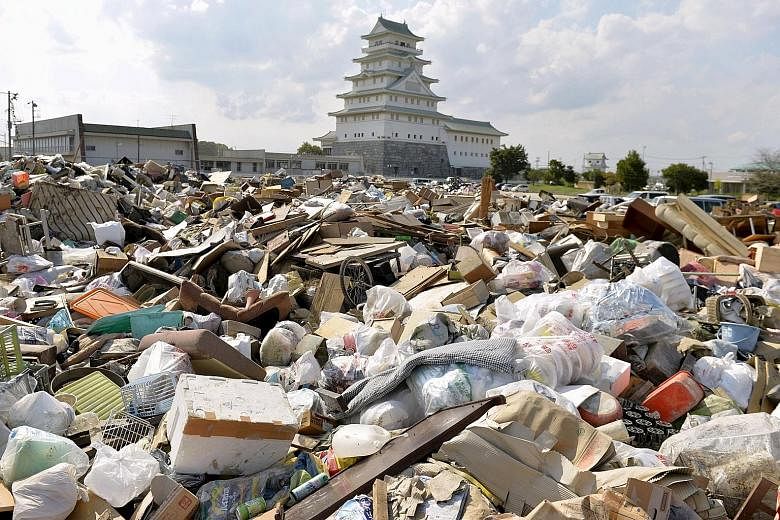TOKYO • The number of people who died in floods which devastated Japan last week reached at least seven, as questions began to swirl about the cause of the disaster in Joso, a community of 65,000 residents 60km north-east of Tokyo.
A huge solar power plant project near the Kinugawa river has been blamed for exacerbating the disastrous flooding in Joso by reportedly shaving off the top of a natural sandbank, reported Kyodo News.
Parts of Joso were washed away on Thursday when a levee on the river gave way, flooding an area that reportedly spans 32 sq km, after the worst rains in decades.
The removal of the layer of sand lowered the height of the embankment which had served as a natural barrier, said mayor Eiichi Yoshihara of Bando city, which is next to Joso.
The land ministry had reportedly said the embankment was private property. But ministry officials refused to confirm the cause of the flooding.
"(The government) has no responsibility over how private property is changed," a ministry official told Kyodo News.
"We cannot be sure that is what caused the flood."
On Saturday morning, Prime Minister Shinzo Abe visited the disaster-hit city in Ibaraki prefecture.
"We're doing our best to make things safe by reconstructing the broken (river)bank as quickly as possible to prevent a repeat of this disaster," Mr Abe said.
Yesterday, police found the bodies of two men in rice paddies.
Earlier in the day, the body of a 68-year-old man was found inside a submerged car in a water-logged rice field in flood-hit Tochigi town.
Joso mayor Toru Takasugi apologised at a press conference for not ordering residents to evacuate before the river burst its banks, local media reported.
"We thought it might break its banks but we couldn't predict where," he said.
"We are deeply sorry for not handling the situation properly."
Four days have passed since the flooding began.
Search operations continued yesterday with 1,800 rescue workers.
They include police, firemen and self-defence forces scrambling to find 15 people still missing in Joso, public broadcaster NHK said.
The area had expected heavy rain yesterday evening.
Officials said over 1,650 people were still at evacuation facilities in Joso yesterday afternoon.
More than 4,000 houses were submerged and water supply was cut off.
The number of missing in Joso dropped from 22 to 15 on Saturday after police found more flood victims alive, including two eight-year-old children.
In Kanuma city, north of Joso, a 63-year-old woman was killed in a landslide, while a 48-year-old woman was found dead in Miyagi prefecture in northern Japan.
A 25-year-old man was also killed while helping to clear clogged drains in Nikko city, known for its historic shrines.
Bags filled with radiation-tainted grass and soil from clean-up work near the crippled Fukushima No. 1 nuclear power plant were swept away in the floodwaters in Iitate, the Environment Ministry said.
A total of 82 bags were found, with 37 of them recovered on Friday, though it remained unclear how many had been washed away, the ministry said.

